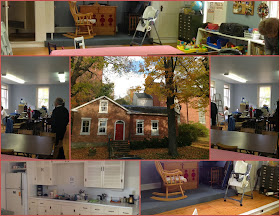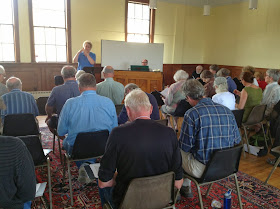On opposite sides of the state, and then tucked right in the
middle between them are three tiny congregations. The outlook and mission of these small
congregations are similarly situated, two being on opposite ends of a sliding
scale and the third somewhere in between.
Looking at various aspects of parochial concern (mission, fellowship,
and facility), the three slide along the scale, in and out of each other,
weaving an intricately colorful aspect of our greater diocesan tapestry. While
one congregation loves their building tenderly as if it were another member of
their family, another feels a sense of liberty in not being bound by bricks and
mortar, so to speak. And the third lies somewhere between, finding solace and
contentment in whatever shelter they find. Where one congregation finds
spiritual fulfillment in being intimately involved within their community, another
finds spiritual fulfillment in their immediate communion. And the third seeks a
balance between both ends. Yet, like all
of the churches and congregations that make up our varied and diverse diocese,
each has a specific calling and the Spirit stirs. None of these three
congregations have more than ten members or so, and that stirring will
necessarily manifest itself in a much simpler manner.
Vermonters have the reputation of sheer stubborn
tenacity. When they want something—and
get it—they tend to hold onto it with all their might and cunning. Never has
that precept been more evident than in the case of St. Paul, Windsor. The
congregation of St. Paul, Windsor has been in a search process for a new priest
for about two years now. They’ve done
their discernment, posted their parish profile and continue to pray. And in the meantime, priestless, they carry
on. They try to find a priest to supply
for the great feasts, sometimes successfully and other times not. Yet, they carry on. They may not celebrate
Holy Eucharist with any regularity, but they still meet every Sunday morning
for Morning Prayer. The five or six, seven or eight members that attend worship
each Sunday are thankful for what they have—a congregation that cares for one
another and the will to persevere. They
also have their church building which to them is as vital to them as another
living entity. It is the silent,
embracing member of the congregation.
 |
| St. Paul's, Windsor |
 |
| St. Paul's organ |
 |
| St. Paul's remaining artwork |
The preservation of St. Paul’s and its heritage is of
mission-level importance to this congregation.
Few as they are, they have undertaken the call to stewardship of their
church with a fervor that could only be inspired by the Holy Spirit. They have made massive repairs in recent
years, including repairing plasterwork over the organ in the gallery, building
a retaining stone wall to prevent erosion, re-gilding the bell tower dome with
gold leaf. They’ve made modern
improvements over the years (like digging out a basement by hand so that they
might have a fellowship/parish hall and installing an elevator for handicap
access) that remain true to the original architectural style of the building. Most of the recent restoration projects have
been funded by grants from organizations such as the Vermont Division for
Historic Preservation (St. Paul’s is listed on the national register of
historical places). It may be said that it’s not the building that makes a
congregation. But in some cases, the
building and its history are formative in lifelong memories. In some cases, God’s Spirit calls to the
mission of preservation. It is right to
answer that call as the good folks in Windsor have done.
 |
| the schoolhouse on Jerusalem Road |
 |
| St. Dunstan's, Waitsfield |
 |
| reredos at St. Dunstan's |
St. Dunstan’s was founded in the late ‘60s-early ‘70s and
was named for the Saint regarded for making church bells. Curiously, no one in the current congregation
seems to know why this patron Saint was chosen as their namesake. To be sure, St. Dunstan is uncommon enough
not to be duplicated in the diocese (not wanting to be amongst the
proliferation of St. Paul, St. Luke, and St. James or even Trinity, the rarity
of St. Dunstan held its appeal to the church founders). St. Dunstan was
Archbishop of Canterbury in the latter part of the 10th century. He
was a blacksmith and silversmith as a tradesman monk and is thus the patron
saint of bell makers, jewelers and other smithy crafters. There is a story of
St. Dunstan shoeing the Devil’s hoof and only removing the painful horseshoe
when the Devil promised never to enter a building with a horseshoe over the
door. Perhaps it was for this determined
“Damn the Devil” attitude that the founders took Dunstan’s name.
The community from which members of St. Dunstan’s hail is
largely comprised of artists and crafters.
Waitsfield is also a ski resort town and the visitors tend to absorb the
artsy atmosphere. Some of the congregation themselves are artists and
organizers of arts programs in the area. And their creativity knows no bounds! The coffee hour I was invited to, for
instance, was no mere beverage and chitchat.
It was a feast of delicate salad and a delectable quiche of homegrown
vegetables—a gustatorial work of art! And conversation entailed storytelling
and an enrichment of tales of wonder and enlightenment. It is indeed evident
that congregations reflect their communities and God works within those local
parameters. This was never more apparent than at St. Dunstan’s.
Even with situations being equal, at least as far as
congregation size is concerned, the concerns and calling of every congregation
is unique. Looking at just a few of our
diocese’s smallest congregations makes this very apparent. St. Paul’s, Windsor; Jerusalem Gathering, Bristol;
and St. Dunstan’s, Waitsfield are all comparable in size, but the way the
Spirit stirs each congregation couldn’t be more unique! As I visit more and more churches in our
diocese, I am touched by each particular expression of God’s Holly Spirit at
work. It makes each church, each parish,
each gathering very special and a gift to the rest of us. We are truly blessed in the Episcopal Diocese
of Vermont!





































